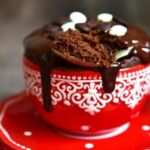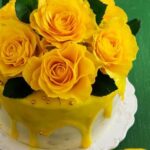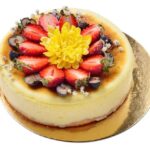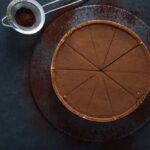Craving for a beautifully decorated butter icing cake? Look no further. In this article, we will be discussing how to decorate butter icing cakes. Whether you’re a professional baker or just starting out, mastering the art of cake decorating with butter icing can elevate your baking game to the next level. From essential tools and ingredients to tips for perfecting your decorations, we’ve got you covered.
Butter icing cakes are a popular choice for special occasions and celebrations due to their smooth texture and versatility in design. Whether it’s a birthday, wedding, or any other event, knowing how to decorate a butter icing cake can help you create stunning and personalized desserts that will leave everyone impressed.
With the right tools and techniques, you can create intricate designs and textures on your butter icing cake that will stand out at any gathering. From piping techniques to incorporating colors and flavors, there are endless possibilities when it comes to decorating with butter icing. So let’s dive into the world of butter icing cake decoration and unleash your creativity.
Essential Tools and Ingredients for Decorating
To create beautifully decorated butter icing cakes, it is essential to have the right tools and ingredients on hand. One of the most important tools for decorating a cake with butter icing is a pastry bag or piping bag, which allows for precise application of the icing. Additionally, different piping tips can be used to achieve various designs, such as flowers, borders, or writing.
Another essential tool for decorating butter icing cakes is an offset spatula, which helps to spread the icing smoothly and evenly across the cake’s surface. A turntable is also helpful for easily rotating the cake while decorating. Other useful tools include a bench scraper for smoothing the sides of the cake and a cake leveler for creating even layers.
In terms of ingredients, it is crucial to use good quality butter and confectioners’ sugar for making butter icing. Flavorings such as vanilla extract or citrus zest can be added to enhance the taste of the icing. Gel food coloring allows for vibrant colors without altering the consistency of the frosting, while edible decorations like sprinkles, edible glitter, or fresh fruit can add an extra touch of visual appeal to the finished cake.
By having these essential tools and ingredients on hand, you’ll be well-equipped to begin decorating your butter icing cakes in a professional and creative manner. Whether you’re a beginner or experienced baker, having the right supplies and materials will make all the difference in achieving beautiful and delicious results.
With attention to detail and practice using these tools and ingredients, you’ll soon discover how fun and rewarding it can be to decorate butter icing cakes with your own unique flair.
Preparing the Cake for Decorating
When it comes to decorating a butter icing cake, the preparation of the cake itself is just as important as the design. To ensure that your cake is ready for decorating, there are a few essential steps that you need to follow:
1. Leveling the Cake: Before you start decorating, it’s important to ensure that your cake has a flat and even surface. Use a serrated knife or a cake leveler to trim off any uneven domes or bumps on the top of the cake.
2. Crumb Coating: To prevent any loose crumbs from ruining the appearance of your final decoration, it’s important to apply a crumb coat of butter icing. This thin layer of icing seals in any crumbs and provides a smooth base for your final decorative layer.
3. Chilling the Cake: After applying the crumb coat, place the cake in the refrigerator for at least 30 minutes to allow the icing to set. This will make it easier to work with when adding your final decorative layer.
By following these steps, you’ll ensure that your cake is perfectly prepped and ready for decorating with butter icing. Once you’ve completed these preparations, you’ll be ready to move on to creating beautiful designs and textures with your butter icing.
Creating Different Textures and Designs With Butter Icing
Butter icing is a versatile and delicious way to decorate cakes, allowing for a wide range of textures and designs. Whether you’re a beginner or an experienced baker, mastering the art of butter icing decoration can take your cake baking skills to the next level. In this section, we will explore different techniques for creating unique textures and designs using butter icing.
One of the most popular ways to create texture with butter icing is by using different piping tips. The star tip is perfect for creating rosettes or stars, while the round tip can be used for simple dots or outlines. For a more intricate design, consider using a petal tip for delicate flower petals or a leaf tip for realistic foliage. Experimenting with different tips will give you variety in your cake decorations.
In addition to piping techniques, you can also use offset spatulas or palette knives to create smooth surfaces, ruffles, or even abstract patterns on your cake. These tools allow you to spread and sculpt the butter icing in creative ways, adding depth and dimension to your designs. By varying pressure and angle, you can achieve a wide range of textures that will make your cake stand out.
Lastly, consider incorporating edible decorations such as sprinkles, edible glitter, or even fresh flowers to add extra flair to your butter icing creations. These elements can complement the texture and design of your butter icing while adding an extra pop of color and visual interest.
| Technique | Description |
|---|---|
| Piping tips | Use different piping tips such as star tip for rosettes or round tip for dots. |
| Offset spatulas/palette knives | Create smooth surfaces or abstract patterns for added depth. |
| Edible decorations | Incorporate items like sprinkles or flowers for extra flair. |
Using Piping Techniques for Intricate Designs
Piping techniques are essential for creating intricate and beautiful designs on butter icing cakes. Whether you’re a beginner or an experienced baker, mastering the art of piping can take your cake decorating skills to the next level. In this section, we will explore the different piping techniques that you can use to create stunning designs on your butter icing cakes.
Types of Piping Tips
There are various types of piping tips that you can use to achieve different designs and textures on your butter icing cake. Some common types of piping tips include round tips for outlining and writing, star tips for rosettes and borders, petal tips for flower petals, leaf tips for leaves, and ruffle tips for creating ruffled textures. Each type of piping tip offers a unique way to add dimension and visual interest to your cake decorations.
Basic Piping Techniques
One of the most basic piping techniques is the pressure piping technique, which involves applying even pressure to the pastry bag while guiding the tip to create smooth lines or borders. Another essential technique is the shell border technique, where you create a series of overlapping shells along the edge of the cake. Additionally, practicing freehand piping can help you develop precision and control when creating custom designs and patterns.
Advanced Piping Techniques
For those looking to take their cake decorating skills to the next level, there are advanced piping techniques such as stringwork, basketweave, and lacework. These techniques require patience and practice but can result in incredibly intricate and visually stunning decorations. By mastering these advanced techniques, you can elevate your butter icing cakes to works of art.
As you hone your skills with different piping techniques, remember that practice makes perfect. Don’t be afraid to experiment with different piping tips and techniques to find what works best for you. With time and dedication, you’ll be able to create show-stopping butter icing cake decorations that will impress any crowd.
Incorporating Colors and Flavors Into Butter Icing
Adding colors and flavors to butter icing is a fun way to customize your cake and make it even more delicious. To add color to your butter icing, you can use gel food coloring, which is vibrant and concentrated, allowing you to achieve the perfect shade. Start by adding a small amount of coloring at a time, as a little goes a long way.
Mix well after each addition until you reach your desired color. You can also combine different colors to create unique shades for your cake.
When it comes to adding flavors to butter icing, the possibilities are endless. You can use extracts such as vanilla, almond, or citrus to add a boost of flavor to your icing. Simply add a small amount of extract at a time and taste as you go until you reach the desired flavor. You can also experiment with other flavorings such as cocoa powder, espresso powder, or fruit purees for a more customized taste.
Adding edible decorations and toppings is another way to enhance the overall look and taste of your butter icing cake. Fresh fruits, chocolate shavings, edible flowers, sprinkles, and nuts are just some of the many options available. These decorations not only add visual appeal but also provide an extra layer of flavor and texture to your cake.
| Butter Icing Tips | Details |
|---|---|
| Coloring Butter Icing | Use gel food coloring for vibrant shades and mix well after each addition |
| Flavoring Butter Icing | Add extracts or other flavorings in small amounts until desired taste is achieved |
| Edible Decorations | Incorporate fresh fruits, chocolate shavings, edible flowers, sprinkles, nuts for added flavor and visual appeal |
Adding Edible Decorations and Toppings
When it comes to decorating a butter icing cake, incorporating edible decorations and toppings can add a beautiful and delicious finishing touch. From fresh fruit to chocolate shavings, there are endless options for enhancing the visual appeal and flavor of your cake.
Here are some popular edible decorations and toppings to consider for your butter icing cake:
- Fresh fruit: Berries, sliced kiwi, or even edible flowers can add a pop of color and freshness to your cake. Consider arranging them in a decorative pattern or placing them strategically on top of the cake.
- Chocolate shavings or curls: Use a vegetable peeler to create delicate chocolate shavings or curls from a bar of chocolate. Sprinkle them on top of the cake for a decadent finish.
- Nuts: Chopped nuts like almonds, pistachios, or hazelnuts can provide a satisfying crunch and texture to your cake. Toast them beforehand for an extra depth of flavor.
- Candied citrus peel: Thin strips of candied orange or lemon peel can add a bright citrusy flavor and a visually appealing touch to your butter icing cake.
- Edible flowers: Certain flowers like rose petals, lavender, or pansies are edible and can be used as elegant decorations for cakes. Make sure to research which flowers are safe for consumption before using them.
By carefully selecting and arranging these edible decorations and toppings, you can elevate the presentation of your butter icing cake while also adding delicious flavors and textures. Experiment with different combinations to find the perfect adornments for your creation.
Tips for Perfecting Your Butter Icing Cake Decorations
When it comes to decorating a butter icing cake, there are some tips and tricks that can help you achieve professional-looking results. Whether you’re a beginner or an experienced baker, these tips for perfecting your butter icing cake decorations will take your creations to the next level.
Consistency Is Key
One of the most important factors in achieving beautiful butter icing decorations is the consistency of the icing. If the icing is too thick, it will be difficult to pipe or spread smoothly, and if it’s too thin, it won’t hold its shape. To achieve the perfect consistency, add small amounts of liquid or powdered sugar until you reach the desired texture.
Practice Makes Perfect
As with any skill, practice is key to perfecting your butter icing cake decorations. Take the time to experiment with different piping tips and techniques to see what works best for you. Don’t be afraid to make mistakes – that’s all part of the learning process. The more you practice, the better your decorations will become.
Attention to Detail
When decorating a butter icing cake, paying attention to detail can make all the difference. Take your time and focus on small details such as smooth edges, even piping lines, and consistent spacing between decorative elements. These small touches can elevate your cake from amateur to professional-looking.
Conclusion and Final Tips for Decorating Butter Icing Cakes
In conclusion, decorating a butter icing cake can be a fun and creative process that allows you to express your artistic talents. With the right tools and ingredients, you can easily create beautiful and intricate designs that will impress your friends and family. By following the steps outlined in this article, you can prepare your cake for decorating, create different textures and designs, use piping techniques for intricate designs, and even incorporate colors and flavors into your butter icing.
To perfect your butter icing cake decorations, it’s important to practice patience and precision. Take your time when creating designs with piping techniques and pay attention to detail. Additionally, don’t be afraid to experiment with different colors, flavors, and edible decorations to make your cake truly unique.
Remember that practice makes perfect when it comes to decorating butter icing cakes. Don’t get discouraged if your first attempts aren’t exactly what you envisioned – keep practicing and honing your skills. And most importantly, have fun with the process.
Decorating a butter icing cake should be an enjoyable experience, so let your creativity shine and don’t be afraid to try new techniques and designs. With dedication and a little bit of creativity, you’ll be able to create stunning butter icing cake decorations that will wow everyone who sees them.
Frequently Asked Questions
How Do You Stick Decorations to a Buttercream Cake?
Decorations can be stuck to a buttercream cake by gently pressing them onto the icing. Make sure the buttercream is still slightly soft so that the decorations adhere well without damaging the cake.
How Do You Top a Cake With Buttercream?
To top a cake with buttercream, start by spreading a generous amount of buttercream on top of the cake using a spatula. Smooth it out evenly and then use piping bags and tips to create decorative designs or swirls on top of the buttercream.
How Do You Make Buttercream Look Good?
Making buttercream look good involves using proper piping techniques to create attractive designs or patterns on the cake. It’s important to use the right consistency of buttercream, as well as experimenting with different piping tips to achieve the desired look. Additionally, adding edible decorations like sprinkles or edible flowers can enhance the overall appearance of the buttercream.

Welcome to my blog about home and family. This blog is a place where I will share my thoughts, ideas, and experiences related to these important topics. I am a stay-at-home mom with two young children. I hope you enjoy reading it! and may find some helpful tips and ideas that will make your home and family life even better!





